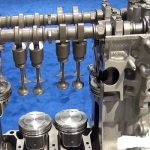
Wärtsilä dual-fuel engines
The Wärtsilä dual-fuel engines are unique because they have two different injection systems. A micro pilot injection system injects a very small amount of liquid fuel when the engine is operating in gas mode. The micro pilot system is of the common rail type, which allows for very small injection amounts.
This makes it possible to meet very stringent emission regulations, which would be impossible if a normal injection system were used. A conventional injection system is used when the engine is run on liquid fuel such as heavy fuel oil or of course diesel oil if that is the fuel choice. Fuel flexibility and high efficiency are the main advantages of the dual-fuel technology. Two engine models are offered at the moment, the Wärtsilä 32 DF and Wärtsilä 50DF. The latter has shown an efficiency of over 48%, which is probably a record at this time.
Wärtsilä gas-diesels were the first gas engines offered by the company. The first engines have now been in operation for almost 70,000 h. The concept was initially developed for the offshore market, where it has been successfully applied in a large number of floating production units. However, these engines have also been used in numerous power plants because of their fuel flexibility. In the gas diesel the gas is injected according to a diesel process at high pressure. A small amount of liquid fuel is pilot injected when the engine is operating in gas mode. A gas diesel can operate on gas with pilot injection and also on liquid fuels such as diesel oil, heavy fuel oil or even crude oil. In gas mode the gas diesel is more tolerant in terms of methane number than other gas engine concepts. Wärtsilä’s gas-diesel engines are the Wärtsilä 32GD and Wärtsilä 46 GD.


